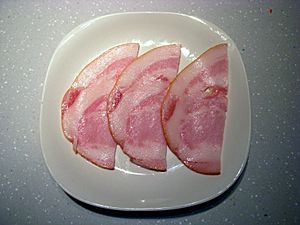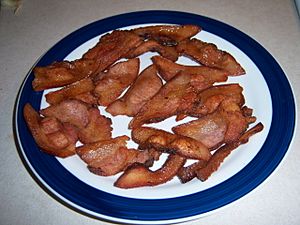Pork jowl facts for kids
Pork jowl is a special cut of meat that comes from a pig's cheek. People around the world use it in different ways. Sometimes it's used fresh, and other times it's cured (preserved with salt) or smoked (cooked slowly with smoke).
In America, when it's cured and smoked, it's often called jowl bacon or hog jowl, especially in the southern parts of the country. Hog jowl is a key part of soul food, which is a type of cooking from the Southern United States. Other countries also have their own traditions; for example, in Italy, a similar cured but not smoked version is called guanciale.
Contents
How Pork Jowl is Used in Cooking
Pork jowl bacon can be fried and eaten as a main dish, much like regular bacon. You might see it as part of a big breakfast.
Adding Flavor to Dishes
Often, pork jowl is used to add flavor to other foods. It's great for seasoning beans, black-eyed peas, or leafy green vegetables like collard greens and turnip greens. These are common dishes in the Southeastern United States.
Other Ways to Enjoy Pork Jowl
You can also chop up pork jowl and use it as a garnish, similar to bacon bits. It can even be served in sandwiches. Sometimes, pork jowl is used as an ingredient that helps hold together pork liver sausages, like liverwurst.
Special Traditions in the US
In the Southern United States, there's a long-standing tradition of eating black-eyed peas and greens with pork jowls or fatback on New Year's Day. This tradition is believed to bring good luck and wealth for the new year.
A Bit of History
This tradition goes back hundreds of years. During the American Civil War (from 1861 to 1865), people in the South thought black-eyed peas represented wealth. Pigs, and pork products like jowl, were seen as symbols of good fortune. Eating them on New Year's Day was a way to hope for a prosperous year ahead.
Storing Pork Jowl
Pork jowl can be cured, which means it's preserved. This is similar to how many other pork cuts are preserved. Because of this, it was a popular food during winter in the past. It could be stored for a long time without needing a refrigerator.



